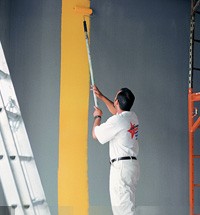The average person may think that cold weather would only have an effect on painting the exterior of a home; however, the low temperatures actually play a large part in painting the interior as well. As the temperature drops into the 30’s or lower, it severely impacts the drying time of your paints – reducing it from 20-30 minutes to less than 5 minutes!
The most common problems that occur from this are picture framing (when the rolling and brushing look different), curtaining (when the paint has a sagging or curtain look to it), and creating an uneven look. When the drying time is sped up, rolling becomes impossible, and you end up putting two coats in some areas and one in others.
Here are some tips to help combat these common cold weather problems:
- Close doors and vents. Although it goes against your instincts, when you’re painting in low temperatures, you want to reduce the amount of air flow to the room by closing doors and vents. This will eliminate any outside drafts and reduce the air circulation, which will slow down the drying time and allow the paint to level out properly.
- Slow the drying time. Adding Floetrol – an additive for flat or semi-gloss latex paints – to your paint will help slow down the drying time and improve the flow and level of the paint. It minimizes brush and roller marks to improve your paint performance with little effort. Note: Floetrol is a paint conditioner, not a thinner. It doesn’t affect the paint’s adhesion.
- Use quality painting products. The saying “you get what you pay for” holds true. Investing in a quality roller with the proper nap can make a difference in achieving an even finish.
- Apply paint evenly. Don’t try to conserve paint by over extending it through thin layers. The proper amount of paint must be used on your walls. Trying to over-extend your paint will only make the problem larger by reducing the flow and leveling of the coat.
You can also get around the cold temperature problems by choosing a different type of paint. With latex paints, if the weather is below 50 degrees Fahrenheit, the paint will crack and a powdery film may form. This will make your paint look like a lighter shade of the color you selected.
Oil/alkyd paints can be used when the temperature is as low as 40 degrees Fahrenheit; but if there is moisture in the air (humidity or foggy conditions), the paint can become blotchy and show differences in the color.
The temperature outside should not be your only concern. You must also keep in mind the temperature of your paint. If you store your paint in a setting below 40 degrees Fahrenheit, and then apply the paint at the same temperature, it won’t have proper flow and brushing characteristics.
Having to redo a paint project can get pricey, so if you’re feeling unsure about tackling your next painting project, contact Bainbridge Painters today!




